|
Summary: The setting Sun became
a strange-looking crescent in central parts of the United States
on June 10, 2002, during a partial solar eclipse. [full
story]
Page
1 | Page
2 | Page
3 | Page
4 | This
is Page 5
Unless
otherwise stated, all images are copyrighted by the photographers.
|
|
Photographer, Location, Date |
Larger images |
Comments |
 |
Chris
Go, Cebu City, Philippines |
#1, #2,
more |
Chris Go captured these images on June 11 when
the eclipsed Sun rose over the Phiipines. Photo details: Astrophysics
AP130EDF with a 2X AP Barcon; Baader Planetarium Photographic
Density Solar filter; Kodak Pro Image 100 film; 1/500 sec. |
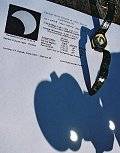 |
Colleen
Meade, Tsawwassen, British Columbia, Canada |
#1,
#2 |
C. Meade: "My daughter held the binoculars
as I snapped this photo, with my watch in to mark the time of
the maximum obscuration." |
 |
Monte
Allaman, Dallas, Texas, USA |
#1 |
M. Allaman snapped this extraordinary photo of
a jet flying past the partially eclipsed Sun. |
 |
Darren
M. Brooks, Albuquerque, New Mexico, USA |
#1 |
D. Brooks: "It's a bit faint, but within
my shadow cast on the floor is a projected image of the eclipse.
My shadow shows me holding the 6x23 binoculars I used to project
the sun while I snapped the picture with my Olympus digital PNS.
Kind of an 'Artist and Subject' shot." |
 |
Alejandro
Bascolo, Benbrook Lake, near Fort Worth, Texas, USA |
#1,
#2 |
Photo details: Pentax P30 with Hoya polarizer,
Fuji ASA 400, 1/250 s exposure. |
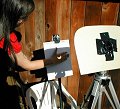 |
Bill
Sherman, Hayward, CA, USA |
#1,
#2 |
B. Sherman: "Surprisingly good results of
photographing the eclipse can be had with a simple setup. I rubber
banded a Russian monocular to a tripod and projected the image
on a sheet of paper. An Olympus D-370 digital camera recorded
the image. The close up shot was made using the camera's macro
mode. Note the large sunspot formed an eye for this 'pacman'
shot of the sun." |
 |
Mustapha Nasir
and friends, Sabah Malaysia (North Borneo) |
#1, #2 |
In Maylasia the partial eclipse began at sunrise
on June 11th. |
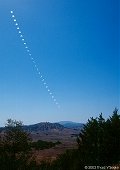 |
Thad V'Soske,
San Diego, CA, USA |
#1 |
Thad: "This wide-angle multi-exposure image
was shot near Santa Ysabel, California, using Kodak E100VS, and
a 17-35mm Canon lens at 35mm. It was a wonderful event both to
see and photograph!" |
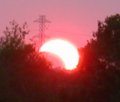 |
Barbara
Wilson, from Addicks Dam near Houston, Texas, USA |
#1, #2 |
B. Wilson: "We went to the western edge
of Houston because the city is so flat there that not a single
blade of grass would prevent one from watching the sunset eclipse!" |
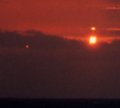 |
Jay
Friedland, near Los Playitos, Mexico |
#1,
#2 |
J. Friedland: "All these photos were taken
1 km north of Los Playitos,
Mexico, about half way between the centerline and northern limit
of the path of annularity. We were set up on this incredibly
beautiful beach
... but were clouded out - then at the last possible moment the
sun broke through the clouds for a minute or so right before
sunset." |
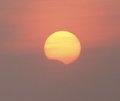 |
Les Marczi,
near Niagra Falls, Canada |
#1,
#2 |
L. Marczi: "It was a fantastic sunset, one
I will remember for a while." |
 |
James Kevin
Ty, Phil. Astronomical Society, Manila, Philippines |
#1, #2,
#3, #4,
#5 |
This is a multiple-exposure shot of the June
11 eclipse taken by James Kevin Ty from 5:40am-7:10am. He used
a Canon EOS 50E with a Tamron 28-200mm f/3.8~5.6 zoom lens set
at f/16 with Thousand Oaks Type 2+ solar filter and Fuji 100
film. Exposures were all 1/1000 sec except the first image which
was taken at 1/250sec. |
 |
Daniel
L. Baker, Harrisville, West Virginia, USA |
#1, #2, #3 |
D. Baker: "Here in the Harrisville, WV area
the sun became blocked by haze just before the eclipse began,
and wasn't viewable to the naked eye. Fortunately the camera
was able to catch the sun's light through the haze." |
MORE IMAGES
- from Jonathan Dietch
of Long Beach, CA: image
|














